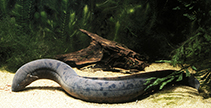http://www.fishbase.org/Summary/speciesSummary.php?genusname=Lepidosiren&speciesname=paradoxa ---> http://192.134.151.83/Summary/speciesSummary.php?genusname=Lepidosiren&speciesname=paradoxa
http://192.134.151.83/Summary/speciesSummary.php?genusname=Lepidosiren&speciesname=paradoxa ---> https://fishbase.mnhn.fr/Summary/speciesSummary.php?genusname=Lepidosiren&speciesname=paradoxa
https://fishbase.mnhn.fr/Summary/speciesSummary.php?genusname=Lepidosiren&speciesname=paradoxa ---> https://fishbase.mnhn.fr/summary/Lepidosiren-paradoxa.html
Lepidosiren paradoxa, South American lungfish : fisheries

You can
sponsor
this page
Common name (e.g. trout)
Genus + Species (e.g. Gadus morhua)
-

-
About this page
-
Languages
-
User feedbacks
-
Citation
-
Uploads
-
Related species
-


 South American lungfish
Upload your
photos
and
videos
South American lungfish
Upload your
photos
and
videos
Pictures
|
Google image
 Lepidosiren paradoxa
Lepidosiren paradoxa
Picture by
Muséum-Aquarium de Nancy/D. Terver
Dipneusti (lungfishes) >
Ceratodontiformes
(Australian lungfishes) >
Lepidosirenidae
(Aestivating lungfishes)
Etymology:
Lepidosiren:
Greek, lepis = scale + Greek, seiren = a mythological serpent, 1520 (Ref.
45335
)
.
Environment: milieu / climate zone / depth range / distribution range
Ecology
Freshwater; demersal. Subtropical; 24°C - 28°C (Ref.
2060
); 5°N - 35°S
South America: Amazon, Paraguay and lower Paraná River basins.
Size / Weight / Age
Maturity: L
m
?
range ? - ? cm
Max length : 125 cm TL male/unsexed; (Ref.
36887
); max. reported age: 8 years (Ref.
274
)
Obligate air-breathing (Ref.
126274
); Prefers stagnant waters where there is little current. Juveniles feed on larval insects and snails. Adults are omnivorous and feed on aquatic vertebrates, invertebrates such as snails, clams and shrimp, and algae (Ref.
36739
). Can survive low oxygen levels in its habitat by means of its very reduced branchial apparatus. It possesses two lungs without bronchial tubes. During the dry period, this species burrows into the mud, to a depth of about 30-50 cm, and seals off the entrance with clay, leaving out 2-3 holes for aeration. It reduces its metabolism during this period of hibernation. The fish are obligate air-breathers and will drown if denied access to the surface (Ref.
36739
). During the rainy season, reproduction begins. The parents gather vegetal debris in a burrow (about 1.5 m long) to create a nest. During reproduction, males guard the young. These males can increase the oxygen level in the burrow because during breading season the pelvic fins develop highly vascularized, gill-like, feathery structures which perform a function opposite to those of gills: they releases oxygen from the blood and take in carbon dioxide; the filaments disappear after the end of the breeding season (Ref.
12225
,
36739
). The young look like amphibian tadpoles with four external gills. During the first weeks of their life they breath only through the external gills; at an age of 7 weeks they become air-breathing and regression of the external gills begins (Ref.
27188
,
36739
).
Life cycle and mating behavior
Maturity
|
Reproduction
|
Spawning
|
Eggs
|
Fecundity
|
Larvae
Spawning occurs during the wet season. Adult males guard and aerate the hachlings and young temporarily. Adult males develop vascular filaments on their paired fins which function either as auxillary to respiration so that they can breathe air without leaving the nest or the fin filaments permit the emission of aerially obtained oxygen in to the nest water, causing the oxygenation of the water surrounding the eggs (Ref.
111170
). The function of the filaments is much debatable as of the present.
Arratia, G.
, 2003. Lepidosirenidae (aestivating lungfishes). p. 671-672. In R.E. Reis, S.O. Kullander and C.J. Ferraris, Jr. (eds.) Checklist of the Freshwater Fishes of South and Central America. Porto Alegre: EDIPUCRS, Brasil. (Ref.
36887
)
IUCN Red List Status (Ref.
130435
)
Least Concern (LC)
; Date assessed:
21 October 2020
CITES
Not Evaluated
Not Evaluated
Threat to humans
Harmless
Human uses
Fisheries: subsistence fisheries
FAO - Publication:
search
|
FishSource
|
More information
Countries
FAO areas
Ecosystems
Occurrences
Introductions
Stocks
Ecology
Diet
Food items
Food consumption
Ration
Common names
Synonyms
Metabolism
Predators
Ecotoxicology
Reproduction
Maturity
Spawning
Spawning aggregation
Fecundity
Eggs
Egg development
Age/Size
Growth
Length-weight
Length-length
Length-frequencies
Morphometrics
Morphology
Larvae
Larval dynamics
Recruitment
Abundance
BRUVS
References
Aquaculture
Aquaculture profile
Strains
Genetics
Electrophoreses
Heritability
Diseases
Processing
Nutrients
Mass conversion
Collaborators
Pictures
Stamps, Coins Misc.
Sounds
Ciguatera
Speed
Swim. type
Gill area
Otoliths
Brains
Vision
Tools
Bio-Quiz
|
E-book
|
Field guide
|
Length-frequency wizard
|
Life-history tool
|
Point map
|
Classification Tree
|
Catch-MSY
|
Special reports
Check for Aquarium maintenance
|
Check for Species Fact Sheets
|
Check for Aquaculture Fact Sheets
Download XML
Summary page
|
Point data
|
Common names
|
Photos
Internet sources
AFORO (otoliths)
|
Aquatic Commons
|
BHL
|
Cloffa
|
BOLDSystems
|
Websites from users
|
Check FishWatcher
|
CISTI
|
Catalog of Fishes
:
genus
,
species
|
DiscoverLife
|
ECOTOX
| FAO - Publication:
search
|
Faunafri
| Fishipedia |
Fishtrace
| GenBank:
genome
,
nucleotide
|
GloBI
|
Google Books
|
Google Scholar
|
Google
| IGFA World Record |
MitoFish
|
Otolith Atlas of Taiwan Fishes
|
Public aquariums
|
PubMed
| Reef Life Survey | Socotra Atlas |
Tree of Life
| Wikipedia:
Go
,
Search
|
World Records Freshwater Fishing
|
Zoobank
|
Zoological Record
Estimates based on models
Phylogenetic diversity index (Ref.
82804
): PD
50
= 1.5352 [Uniqueness, from 0.5 = low to 2.0 = high].
Bayesian length-weight: a=0.00389 (0.00180 - 0.00842), b=3.12 (2.94 - 3.30), in cm total length, based on all LWR estimates for this body shape (Ref.
93245
).
Trophic level (Ref.
69278
): 3.1 ±0.46 se; based on food items.
Resilience (Ref.
120179
): Very Low, minimum population doubling time more than 14 years (tmax=>22; Fec = 22).
Fishing Vulnerability (Ref.
59153
): High to very high vulnerability (75 of 100).
Price category (Ref.
80766
):
Unknown
.
Back to Search
Random Species
Back to Top
Accessed through:
Not available
FishBase mirror site :
localhost
Page last modified by :
mrius-barile
- 20 July 2016
Fatal error
: Uncaught ArgumentCountError: Too few arguments to function checkEcotox(), 1 passed in /var/www/html/summary/speciessummary.php on line 2304 and exactly 3 expected in /var/www/html/includes/speciessummary.lib.php:2579 Stack trace: #0 /var/www/html/summary/speciessummary.php(2304): checkEcotox() #1 {main} thrown in
/var/www/html/includes/speciessummary.lib.php
on line
2579
|